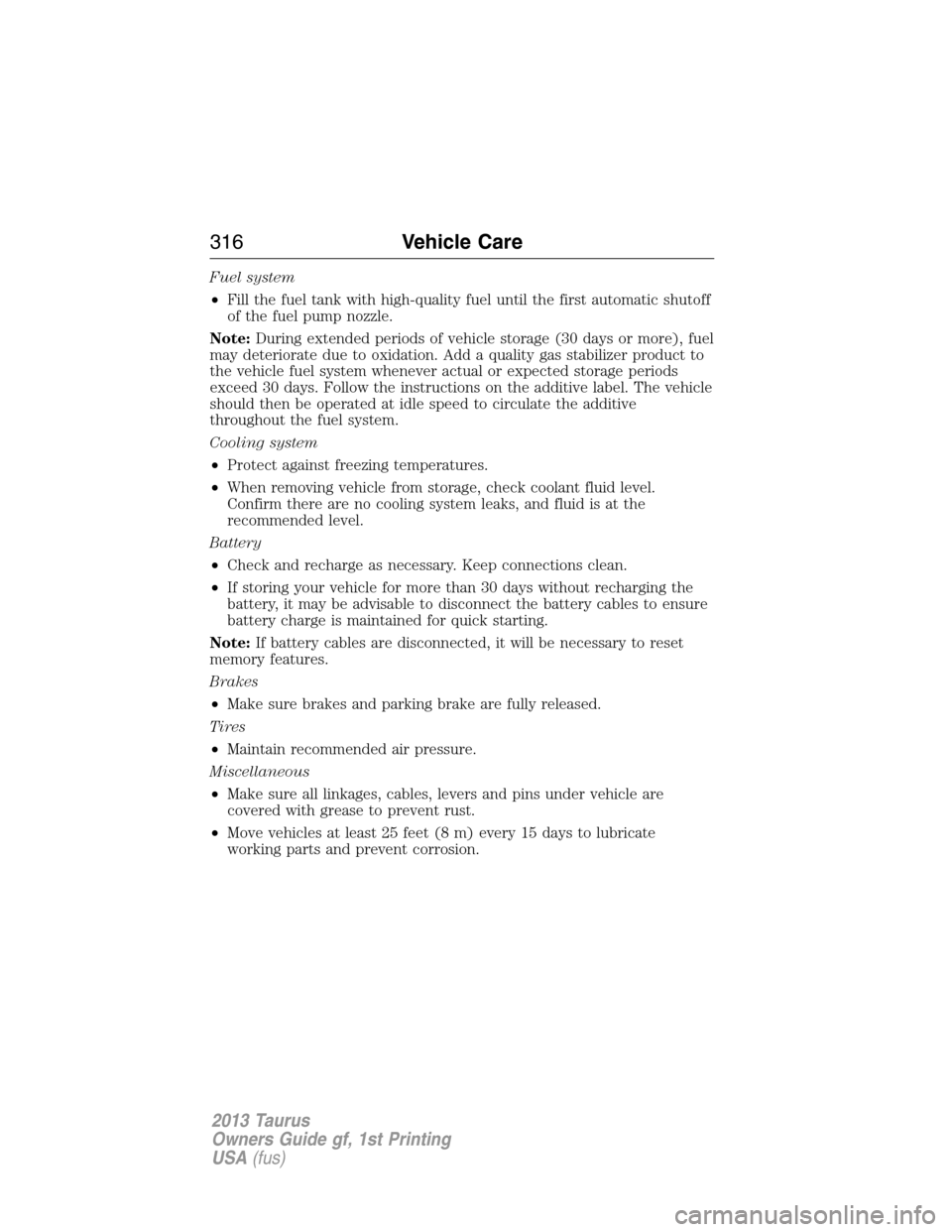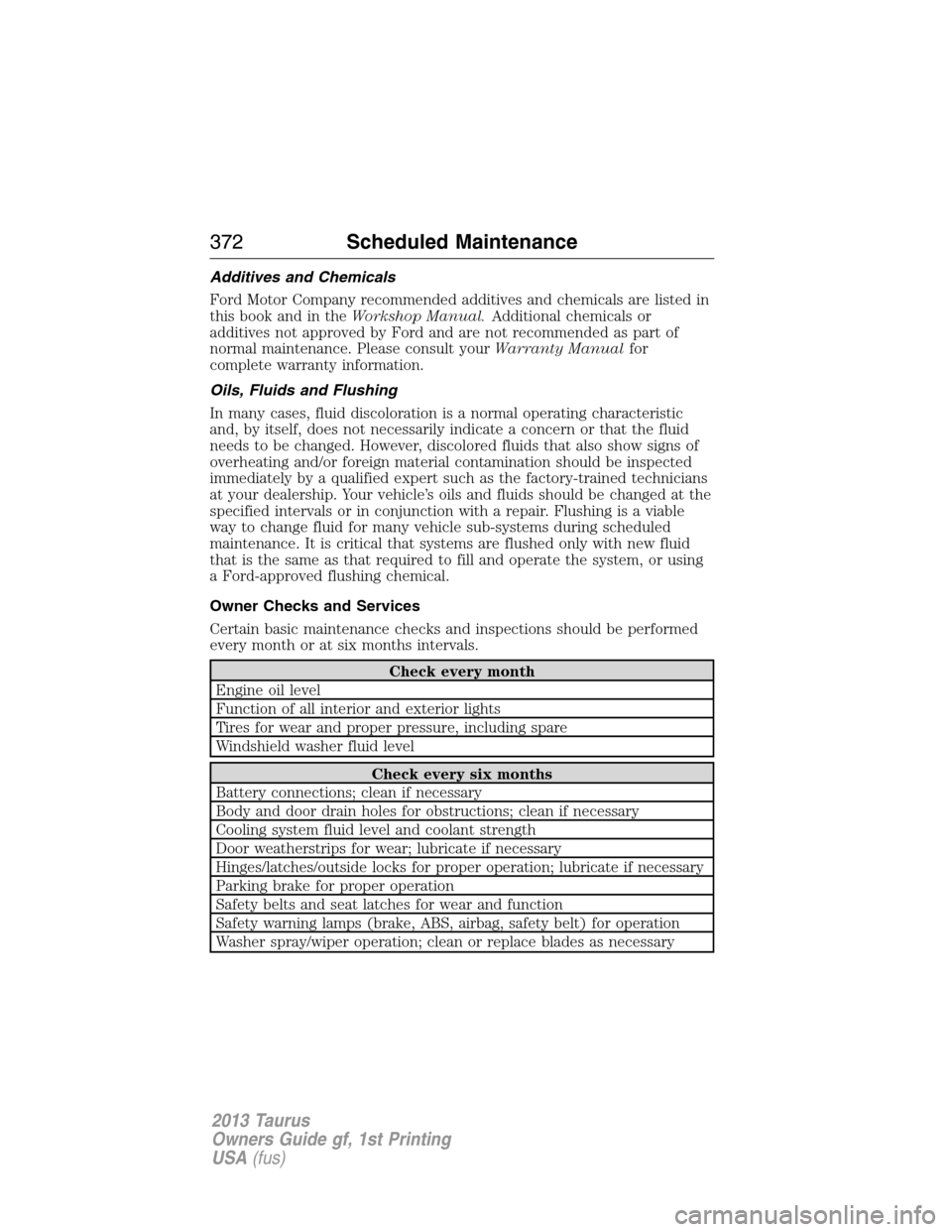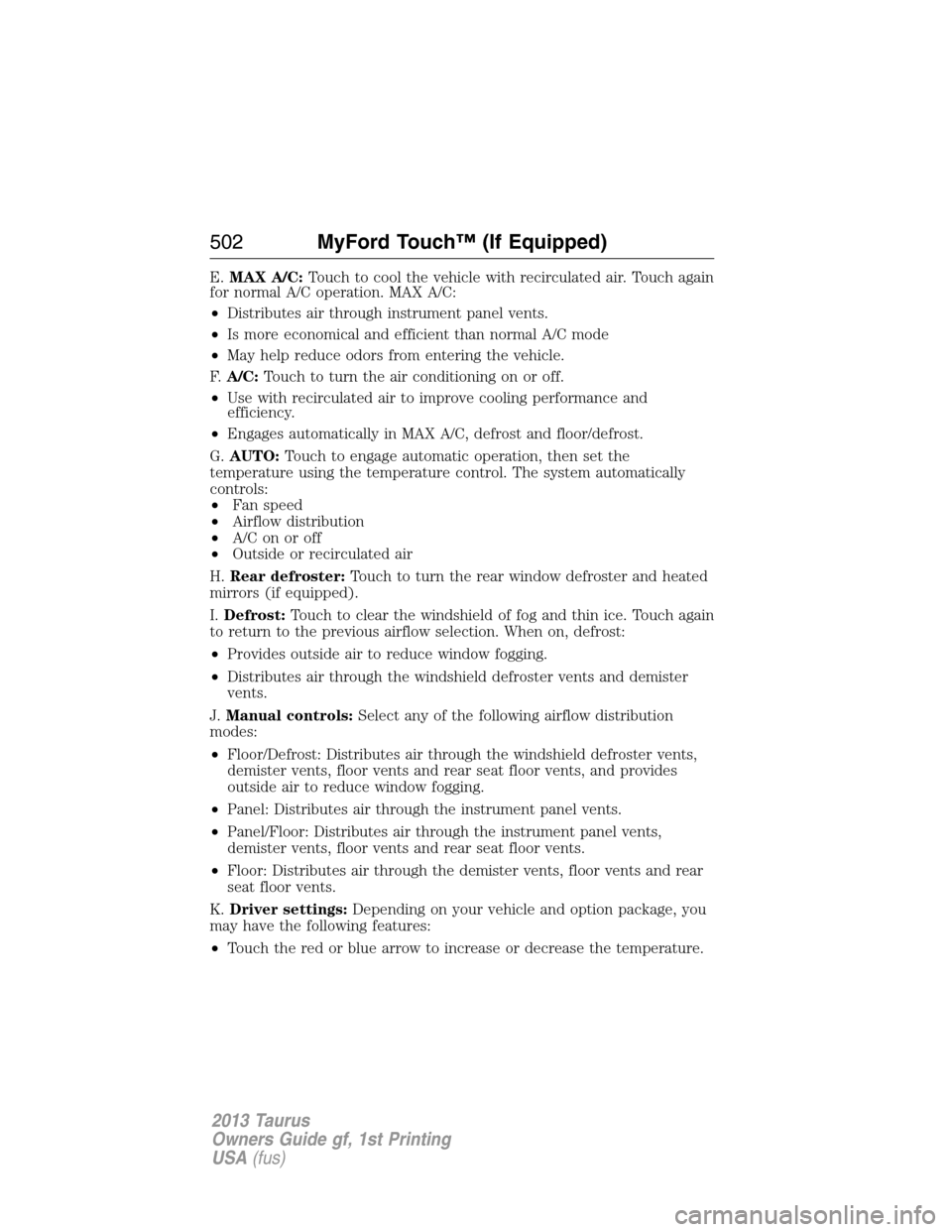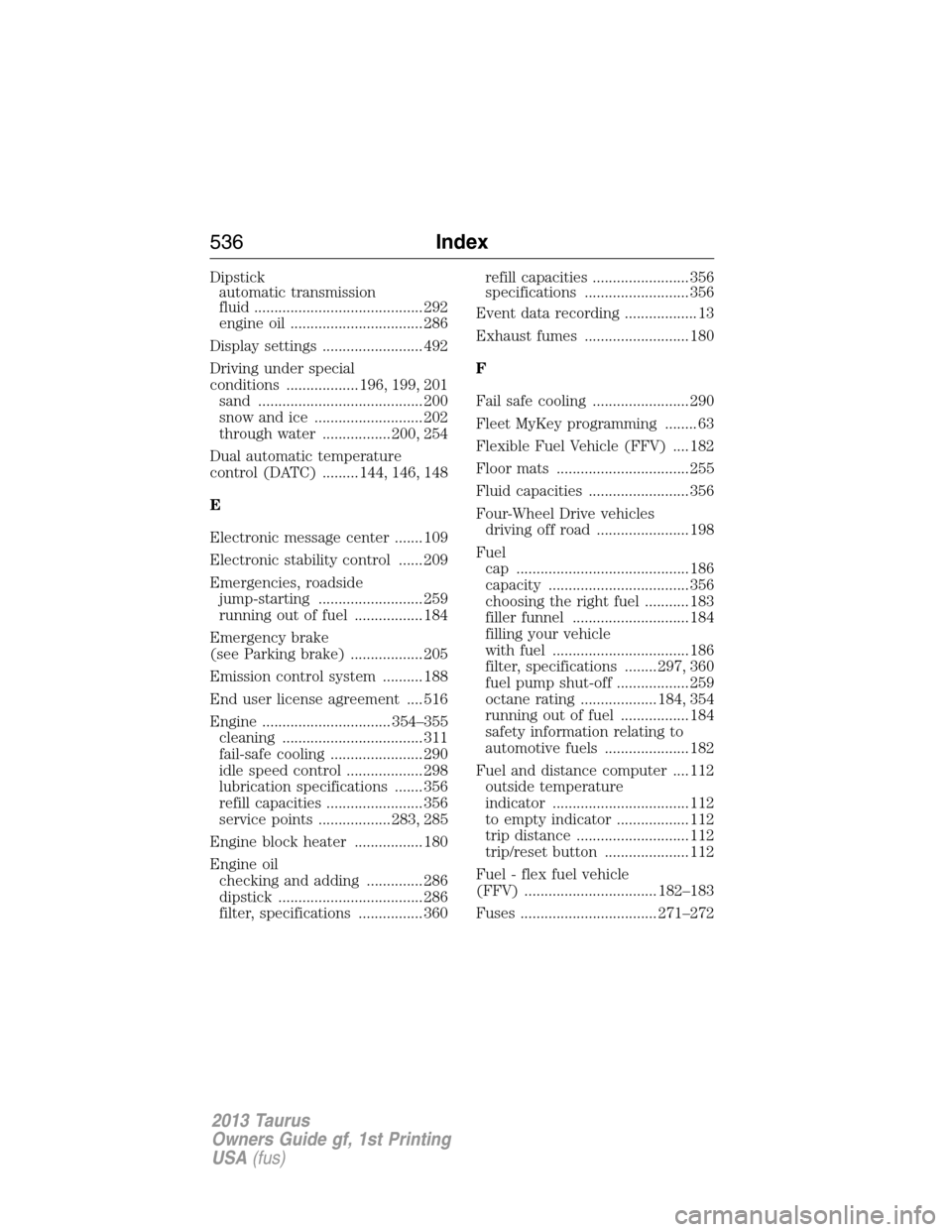2013 FORD TAURUS cooling
[x] Cancel search: coolingPage 296 of 541

High fluid level
If the fluid level is above the MAX
range of the dipstick, remove fluid to
reach the hashmark level.Note:
Fluid level above the MAX level may
cause shift and/or engagement concerns and/or possible damage.
High fluid levels can be caused by an overheating condition. If your
vehicle has been operated for an extended period at high speeds, in city
traffic during hot weather or pulling a trailer, the vehicle should be
turned off until normal operating temperatures are reached. Depending
on vehicle use, cooling times could take up to 30 minutes or longer.
Adjusting Automatic Transmission Fluid Levels
Before adding any fluid, make sure the correct type is used. The type of
fluid used is normally indicated on the dipstick and also in theTechnical
specificationssection in this chapter.
Note:Use of a non-approved automatic transmission fluid may cause
internal transmission component damage.
If necessary, add fluid in 1/2 pint (250
ml) increments through the filler tube
until the level is correct.
If an overfill occurs, excess fluid
should be removed by an authorized
dealer.
Note:An overfill condition of transmission fluid may cause shift and/or
engagement concerns and/or possible damage.
Do not use supplemental transmission fluid additives, treatments or
cleaning agents. The use of these materials may affect transmission
operation and result in damage to internal transmission components.
For vehicles equipped with the EcoBoost engine, reinstall the air filter
assembly.
After the fluid level has been checked and adjusted as necessary, do the
following:
1. Shut the engine off.
2. Loosen the clamp holding the air filter assembly to the rubber hose.
3. Rotate the air filter assembly 90 degrees clockwise without
disconnecting the sensor.
MAX MIN
MAX MIN
296Maintenance
2013 Taurus
Owners Guide gf, 1st Printing
USA(fus)
Page 316 of 541

Fuel system
•Fill the fuel tank with high-quality fuel until the first automatic shutoff
of the fuel pump nozzle.
Note:During extended periods of vehicle storage (30 days or more), fuel
may deteriorate due to oxidation. Add a quality gas stabilizer product to
the vehicle fuel system whenever actual or expected storage periods
exceed 30 days. Follow the instructions on the additive label. The vehicle
should then be operated at idle speed to circulate the additive
throughout the fuel system.
Cooling system
•Protect against freezing temperatures.
•When removing vehicle from storage, check coolant fluid level.
Confirm there are no cooling system leaks, and fluid is at the
recommended level.
Battery
•Check and recharge as necessary. Keep connections clean.
•If storing your vehicle for more than 30 days without recharging the
battery, it may be advisable to disconnect the battery cables to ensure
battery charge is maintained for quick starting.
Note:If battery cables are disconnected, it will be necessary to reset
memory features.
Brakes
•Make sure brakes and parking brake are fully released.
Tires
•Maintain recommended air pressure.
Miscellaneous
•Make sure all linkages, cables, levers and pins under vehicle are
covered with grease to prevent rust.
•Move vehicles at least 25 feet (8 m) every 15 days to lubricate
working parts and prevent corrosion.
316Vehicle Care
2013 Taurus
Owners Guide gf, 1st Printing
USA(fus)
Page 372 of 541

Additives and Chemicals
Ford Motor Company recommended additives and chemicals are listed in
this book and in theWorkshop Manual.Additional chemicals or
additives not approved by Ford and are not recommended as part of
normal maintenance. Please consult yourWarranty Manualfor
complete warranty information.
Oils, Fluids and Flushing
In many cases, fluid discoloration is a normal operating characteristic
and, by itself, does not necessarily indicate a concern or that the fluid
needs to be changed. However, discolored fluids that also show signs of
overheating and/or foreign material contamination should be inspected
immediately by a qualified expert such as the factory-trained technicians
at your dealership. Your vehicle’s oils and fluids should be changed at the
specified intervals or in conjunction with a repair. Flushing is a viable
way to change fluid for many vehicle sub-systems during scheduled
maintenance. It is critical that systems are flushed only with new fluid
that is the same as that required to fill and operate the system, or using
a Ford-approved flushing chemical.
Owner Checks and Services
Certain basic maintenance checks and inspections should be performed
every month or at six months intervals.
Check every month
Engine oil level
Function of all interior and exterior lights
Tires for wear and proper pressure, including spare
Windshield washer fluid level
Check every six months
Battery connections; clean if necessary
Body and door drain holes for obstructions; clean if necessary
Cooling system fluid level and coolant strength
Door weatherstrips for wear; lubricate if necessary
Hinges/latches/outside locks for proper operation; lubricate if necessary
Parking brake for proper operation
Safety belts and seat latches for wear and function
Safety warning lamps (brake, ABS, airbag, safety belt) for operation
Washer spray/wiper operation; clean or replace blades as necessary
372Scheduled Maintenance
2013 Taurus
Owners Guide gf, 1st Printing
USA(fus)
Page 376 of 541

Normal Scheduled Maintenance - At every oil change interval as
indicated by the message center
Change engine oil and filter
Rotate tires, inspect tire wear and measure tread depth
Perform multi-point inspection (recommended)
Inspect automatic transmission fluid level (if equipped with dipstick);
consult dealer for requirements
Inspect brake pads, shoes, rotors, drums, brake linings, hoses and
parking brake
Inspect cabin air filter (if equipped)
Inspect engine cooling system strength and hoses
Inspect exhaust system and heat shields
Inspect rear axle and U-joints; lubricate if equipped with grease fittings
(AWD vehicles)
Inspect half-shaft boots (if equipped)
Inspect steering linkage, ball joints, suspension, tie-rod ends, driveshaft
and U-joints; lubricate if equipped with grease fittings
Inspect wheels and related components for abnormal noise, wear,
looseness or drag
Reset your Intelligent Oil Life Monitor™ after each engine oil and filter
change; refer to theInstrument Clusterchapter
Do not exceed one year or 10,000 miles (16,000 km) between
service intervals
376Scheduled Maintenance
2013 Taurus
Owners Guide gf, 1st Printing
USA(fus)
Page 502 of 541

E.MAX A/C:Touch to cool the vehicle with recirculated air. Touch again
for normal A/C operation. MAX A/C:
•Distributes air through instrument panel vents.
•Is more economical and efficient than normal A/C mode
•May help reduce odors from entering the vehicle.
F.A/C:Touch to turn the air conditioning on or off.
•Use with recirculated air to improve cooling performance and
efficiency.
•Engages automatically in MAX A/C, defrost and floor/defrost.
G.AUTO:Touch to engage automatic operation, then set the
temperature using the temperature control. The system automatically
controls:
•Fan speed
•Airflow distribution
•A/Conoroff
•Outside or recirculated air
H.Rear defroster:Touch to turn the rear window defroster and heated
mirrors (if equipped).
I.Defrost:Touch to clear the windshield of fog and thin ice. Touch again
to return to the previous airflow selection. When on, defrost:
•Provides outside air to reduce window fogging.
•Distributes air through the windshield defroster vents and demister
vents.
J.Manual controls:Select any of the following airflow distribution
modes:
•Floor/Defrost: Distributes air through the windshield defroster vents,
demister vents, floor vents and rear seat floor vents, and provides
outside air to reduce window fogging.
•Panel: Distributes air through the instrument panel vents.
•Panel/Floor: Distributes air through the instrument panel vents,
demister vents, floor vents and rear seat floor vents.
•Floor: Distributes air through the demister vents, floor vents and rear
seat floor vents.
K.Driver settings:Depending on your vehicle and option package, you
may have the following features:
•Touch the red or blue arrow to increase or decrease the temperature.
502MyFord Touch™ (If Equipped)
2013 Taurus
Owners Guide gf, 1st Printing
USA(fus)
Page 536 of 541

Dipstick
automatic transmission
fluid .......................................... 292
engine oil ................................. 286
Display settings ......................... 492
Driving under special
conditions .................. 196, 199, 201
sand ......................................... 200
snow and ice ........................... 202
through water ................. 200, 254
Dual automatic temperature
control (DATC) ......... 144, 146, 148
E
Electronic message center ....... 109
Electronic stability control ...... 209
Emergencies, roadside
jump-starting .......................... 259
running out of fuel ................. 184
Emergency brake
(see Parking brake) .................. 205
Emission control system .......... 188
End user license agreement .... 516
Engine ................................ 354–355
cleaning ................................... 311
fail-safe cooling ....................... 290
idle speed control ................... 298
lubrication specifications ....... 356
refill capacities ........................ 356
service points .................. 283, 285
Engine block heater ................. 180
Engine oil
checking and adding .............. 286
dipstick .................................... 286
filter, specifications ................ 360refill capacities ........................ 356
specifications .......................... 356
Event data recording .................. 13
Exhaust fumes .......................... 180
F
Fail safe cooling ........................ 290
Fleet MyKey programming ........ 63
Flexible Fuel Vehicle (FFV) .... 182
Floor mats ................................. 255
Fluid capacities ......................... 356
Four-Wheel Drive vehicles
driving off road ....................... 198
Fuel
cap ........................................... 186
capacity ................................... 356
choosing the right fuel ........... 183
filler funnel ............................. 184
filling your vehicle
with fuel .................................. 186
filter, specifications ........ 297, 360
fuel pump shut-off .................. 259
octane rating ................... 184, 354
running out of fuel ................. 184
safety information relating to
automotive fuels ..................... 182
Fuel and distance computer .... 112
outside temperature
indicator .................................. 112
to empty indicator .................. 112
trip distance ............................ 112
trip/reset button ..................... 112
Fuel - flex fuel vehicle
(FFV) ................................. 182–183
Fuses .................................. 271–272
536Index
2013 Taurus
Owners Guide gf, 1st Printing
USA(fus)